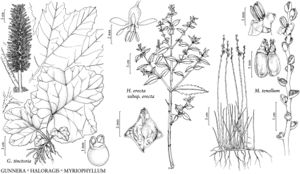Difference between revisions of "Gunnera tinctoria"
Hist. Nat. Pl. 10: 141. 1805.
imported>Volume Importer |
imported>Volume Importer |
||
| Line 59: | Line 59: | ||
|publication year=1805 | |publication year=1805 | ||
|special status= | |special status= | ||
| − | |source xml=https://xjsachs2@bitbucket.org/aafc-mbb/fna-data-curation.git/src/ | + | |source xml=https://xjsachs2@bitbucket.org/aafc-mbb/fna-data-curation.git/src/e39f0e846f172941159b2045254d62d10d9823f6/coarse_grained_fna_xml/V10/V10_669.xml |
|genus=Gunnera | |genus=Gunnera | ||
|species=Gunnera tinctoria | |species=Gunnera tinctoria | ||
Latest revision as of 10:33, 9 May 2022
Herbs 1–2 m. Leaves: petiole 1–1.5 m × 20–45 mm; blade 1–2 m. Peduncles erect, 2–20 cm. Inflorescences 50–75[–100] × 10–25 cm; spikes many, 2–5 cm. Flowers: sepals 1 mm; filaments 0.5 mm; anthers broadly ellipsoid, 0.7–1 mm; styles glandular, 0.7–1.2 mm. Drupes red, 1.5–2[–3] × 1–2 mm. Seeds 1 per fruit. 2n = 34.
Phenology: Flowering spring, fruiting summer.
Habitat: Disturbed, shaded, damp areas.
Elevation: 0–100 m.
Distribution
Introduced; B.C., Calif., Oreg., Wash., s South America (Chile), introduced also in w Europe (Ireland), Pacific Islands (New Zealand).
Discussion
Gunnera tinctoria is cultivated and escaped; it has become naturalized in coastal California (Marin and San Francisco counties), Oregon (Lincoln County), Washington (King County), and British Columbia (Vancouver Island, S. F. Lomer, pers. comm.). Gunnera tinctoria is suitable for a wetland or bog garden, and the rootstock is hardy to -10°C. The young leaf stalks can be peeled and cooked as a vegetable or eaten raw (U. P. Hedrick 1919). Some other species are occasionally cultivated in North America, including the superficially similar G. manicata; none is reported to escape. A good distinguishing character can be found in the large, laciniate, or jaggedly cut scales at the base of the leaves and inflorescences. In G. manicata, there is a prominent development of membranous webbing between the main lobes of the scale, whereas in G. tinctoria this is not well developed and the lobes are often nearly free to the main rachis of the scale (P. A. Williams et al. 2005). In G. tinctoria, the central part of the main inflorescence axis is 4–4.5 cm, versus 3–3.3 cm in G. manicata.
Selected References
None.
